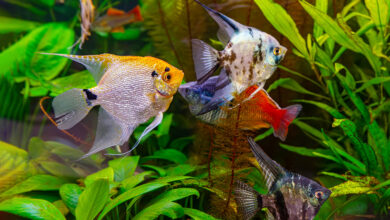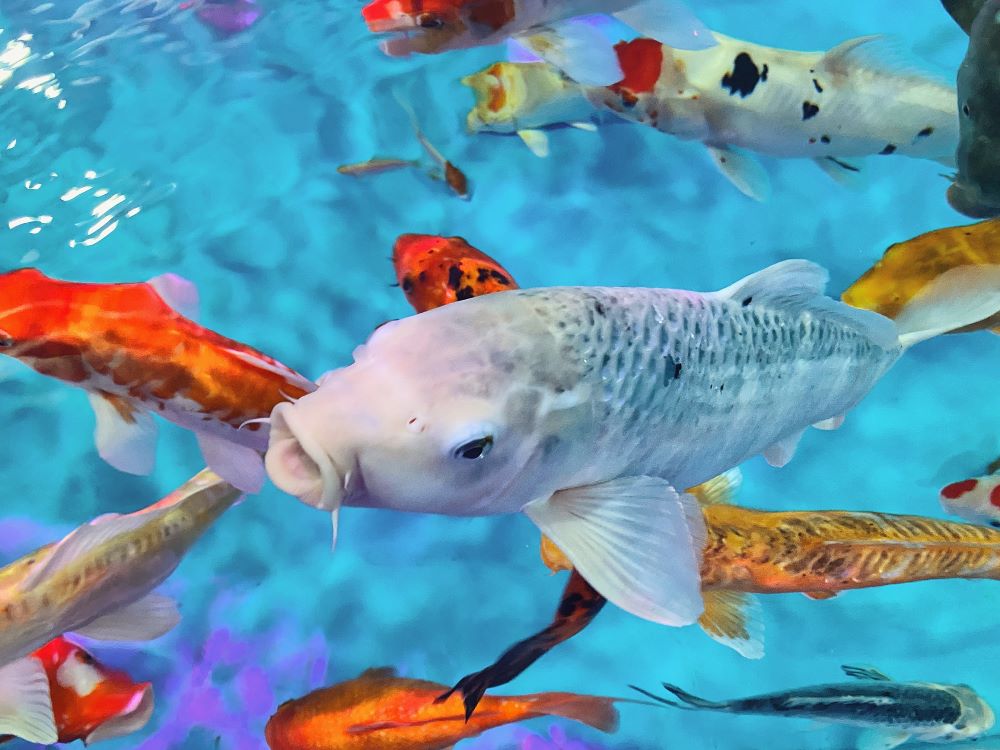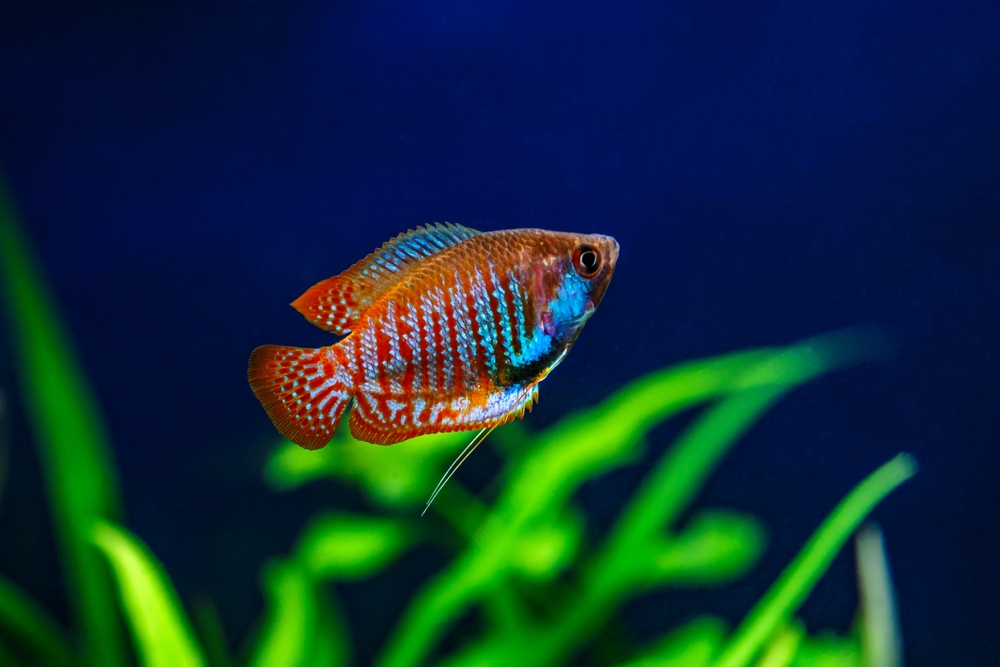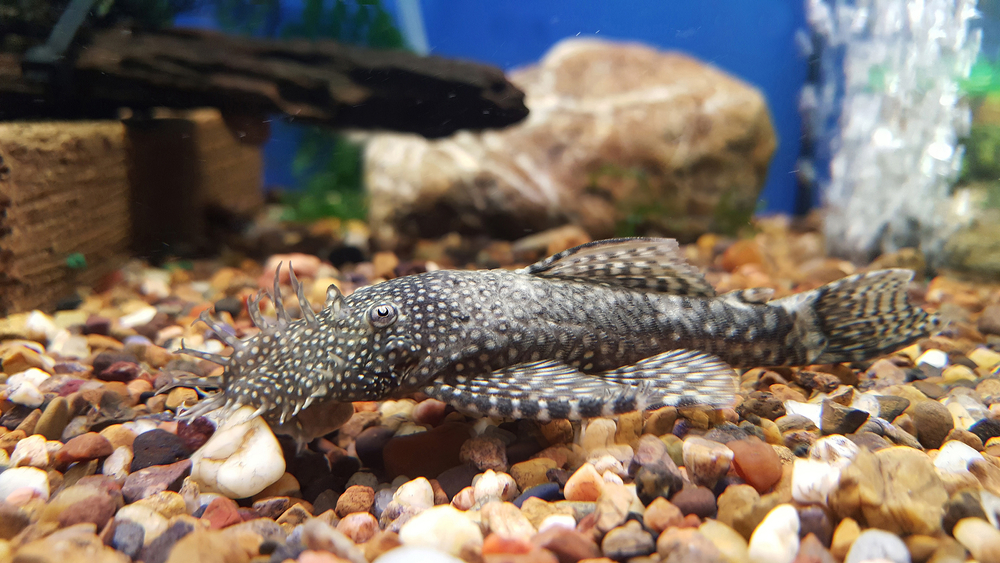Tank Mates Or Targets? Discover Which Fish Can Live With Piranhas
When you purchase through links on our site, we may earn a commission. Here’s how it works.
Forget what you’ve seen in horror movies — not every fish tossed in with a Piranha becomes lunch.
In reality, a few bold species can coexist with these red-bellied predators if you balance temperament, size, and space.
Table of Contents
Piranha Tank Mates – 4 Factors To Consider
Hollywood taught us that a single drop of blood turns piranhas into a feeding frenzy, but in the real world, these fish are more nuanced than the movie monsters they are made out to be. Under the right conditions, they can share a tank with a few hand-picked species that match their size and attitude.
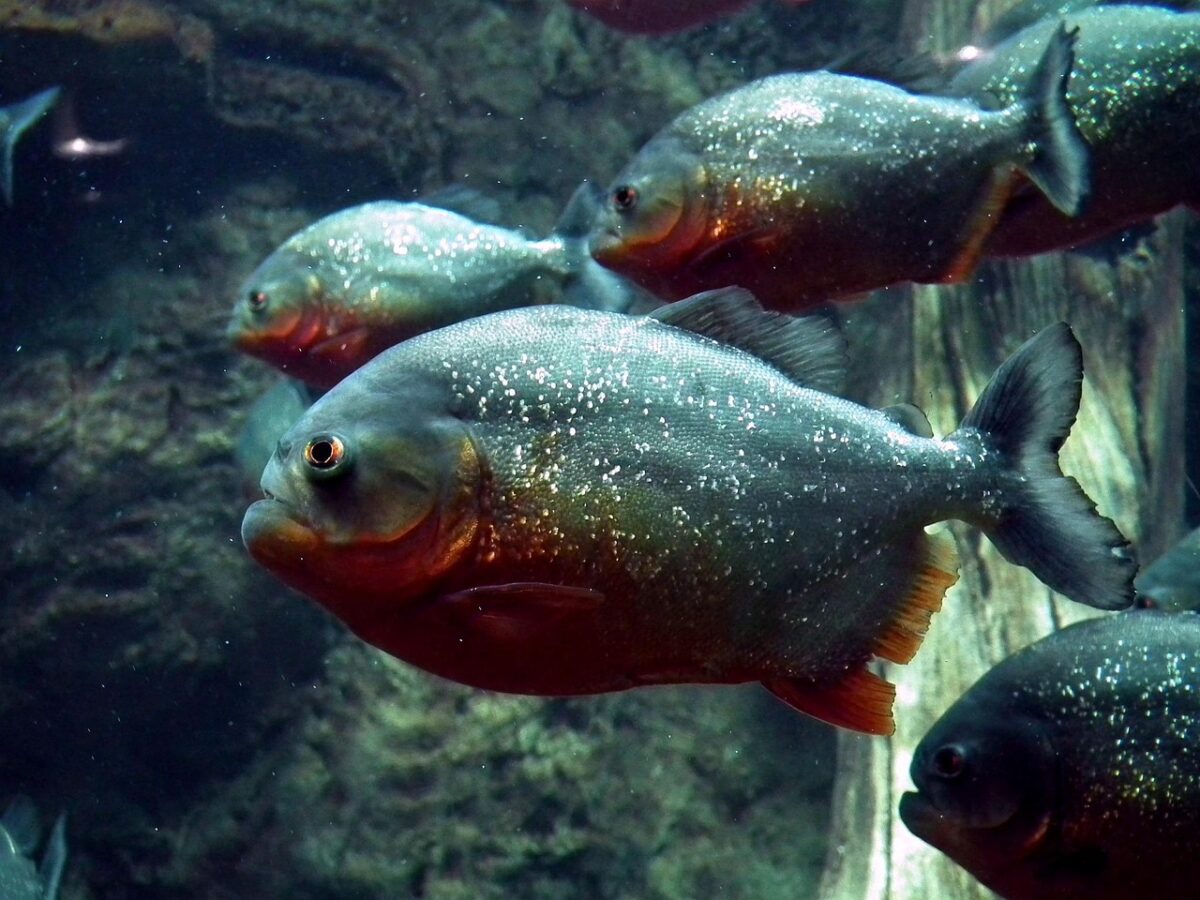
Survival in a piranha tank is not luck. It is strategy. Everything from water temperature to personality determines whether peace or panic reigns below the surface.
1. Temperament
Piranhas are aggressive by design. They defend territory, food, and dominance with little hesitation. When selecting tank mates, choose fish that can stand their ground but are not prone to constant fights. Semi-aggressive cichlids, large catfish, or armored bottom dwellers are safer bets than timid community fish that will end up as dinner.
Tank Wisdom: Match aggression levels, not opposites. A calm fish among predators is a recipe for disaster.
2. Size
Small fish do not last long. Stick with species of equal or greater size, ideally 8 inches or more once mature. Larger tank mates are less likely to be seen as prey, and the size balance helps keep the peace.
Fast Fact: Even well-fed piranhas are opportunistic. If it fits in their mouth, it is on the menu.
3. Competition
Piranhas are meat-eaters. If your tank mates share the same carnivorous cravings, expect tension during feeding time. Look for fish with slightly different diets, such as omnivores or scavengers that clean up leftovers rather than compete for them.
Feeding Fix: Drop food in multiple areas of the tank to diffuse feeding frenzies and reduce direct conflict.
4. Parameters & Tank Setup
Warm, stable water and space are everything. Keep temperatures between 75°F and 82°F and pH near neutral (6.5–7.5).
A roomy tank with dense plants, driftwood, and caves helps each fish stake out territory and hide when needed. Overcrowding quickly leads to shredded fins.
Setup Snapshot
- Minimum tank size: 100 gallons for mixed species
- Strong filtration and oxygenation
- Visual barriers like plants or rocks to break the line of sight
Compatibility Snapshot
Even the least experienced aquarists know that choosing the wrong companion for a piranha can turn peaceful coexistence into chaos overnight. The key is to find species that balance confidence with caution.
Use the chart below as a quick reference before adding any new fish to your setup.
| Factor | Best For Piranha Tanks | Avoid |
|---|---|---|
| Temperament | Semi-aggressive, confident fish | Timid or delicate species |
| Size | 8–16 inches | Under 5 inches |
| Diet | Omnivores, scavengers | Small carnivores or grazers |
| Habitat Level | Mid to bottom dwellers | Surface swimmers |
4 Types Of Fish That Can Live With Piranhas
While few fish can truly coexist with piranhas, certain types have the right mix of size, attitude, and armor to hold their own. These general categories tend to fare best in well-managed, spacious aquariums.
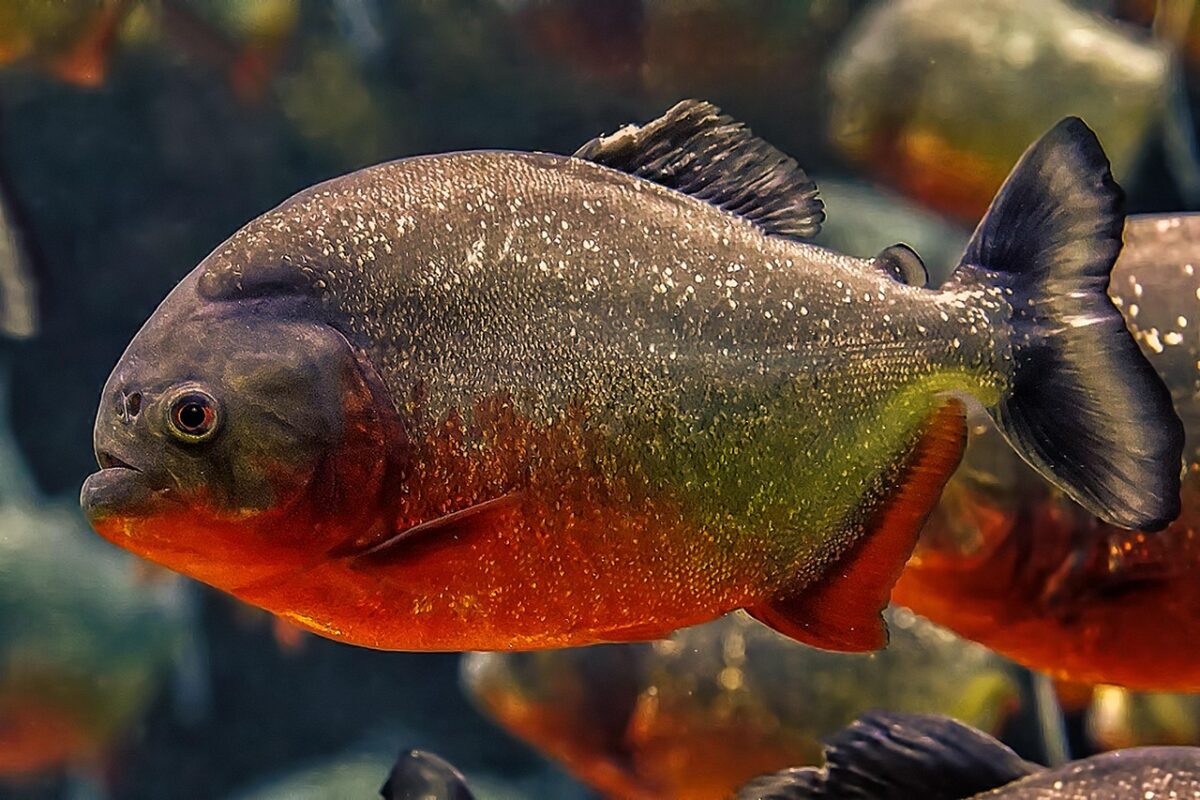
- Large, Aggressive Cichlids: These confident, thick-bodied fish can defend their territory and won’t be easily intimidated. Their shared temperature and pH preferences with piranhas make them natural contenders for mixed setups.
- Armored or Bottom-Dwelling Scavengers: Species with heavy plating, tough skin, or a preference for life along the substrate are less likely to trigger aggression. Their slow movements and low profiles help them stay off a piranha’s radar.
- Fast, Schooling Fish: Speed and numbers can be a survival tactic. Schooling species that stay in motion and occupy the mid- to upper-water column can often coexist peacefully. Their largely herbivorous diets also limit competition during feeding time.
- Giant “Oddballs”: In massive aquariums, even enormous species like gouramis or catfish can live with piranhas. Their sheer size discourages attacks — but these combinations are only realistic for experienced aquarists with very large tanks.
Note: Avoid small or delicate species with long, flowing fins. Angelfish, guppies, and bettas make easy targets and rarely survive long in a predator tank.
18 Piranha Tank Mates
Adding tank mates to a piranha aquarium is not for the faint of heart. Each fish on this list brings its own attitude, size advantage, and survival strategy to the mix. If you are considering expanding your setup, start with these tried-and-tested options that can hold their own in a tank full of teeth.
1. Oscar Fish
Large, fearless, and surprisingly intelligent, the Oscar is one of the few fish bold enough to coexist with piranhas. Its stocky build and assertive personality make it a natural contender in any high-stakes aquarium. They also share similar water parameters, which simplifies tank management.
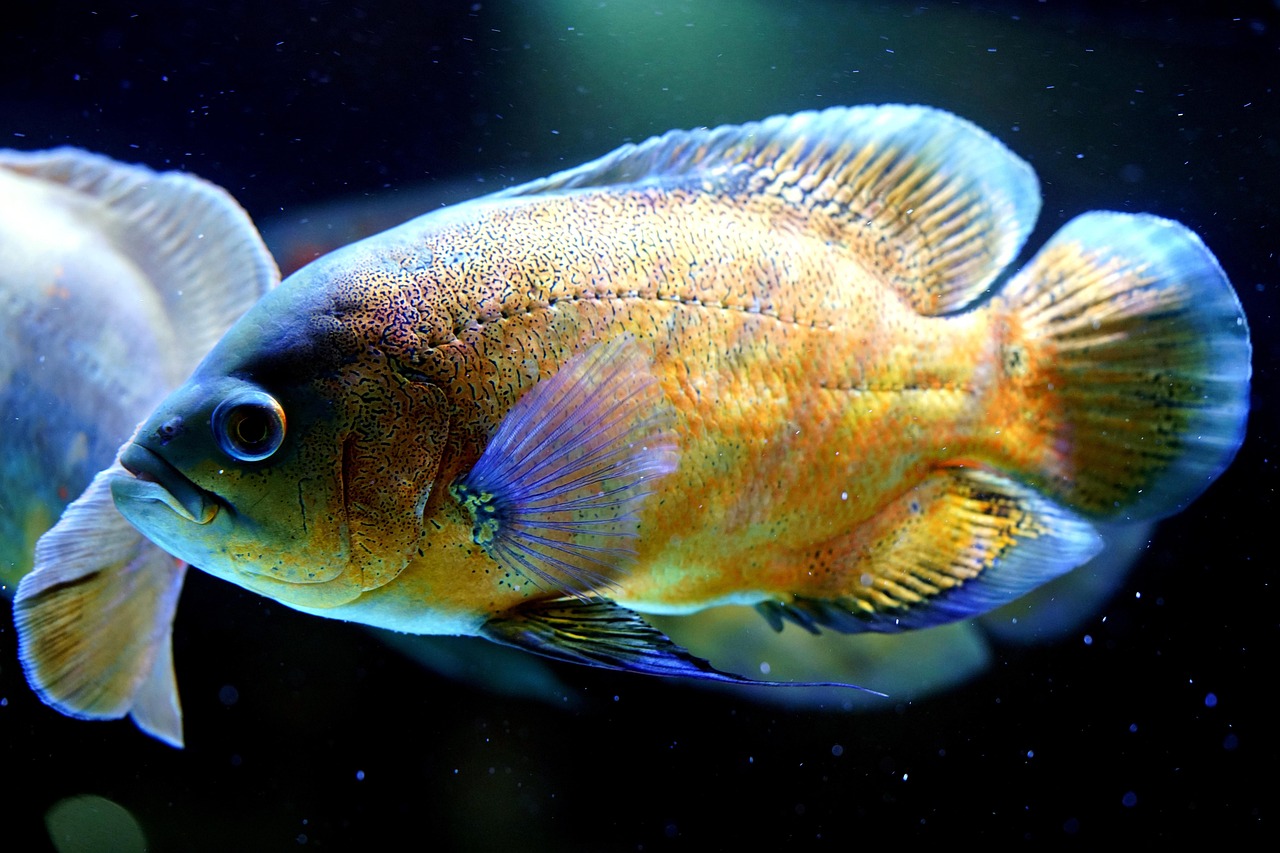
- Scientific Name: Astronotus ocellatus
- Adult Size: 10–16 inches
- Care Level: Moderate
- Origin: South America
- Compatible With: Jack Dempsey, Common Pleco, Firemouth, Clown Loaches
Pros
- Confident and resilient in aggressive setups
- Thrive in similar water conditions as piranhas
Cons
- Can become territorial during breeding
- Vulnerable if smaller than their tank mates
- Can be prone to hole-in-the-head disease if water quality drops, so regular maintenance is essential.
Tank Fit: Oscars make strong companions if they are larger than the piranhas. If they are smaller, they are likely to become targets.
2. Jack Dempsey
Named after the heavyweight boxer, the Jack Dempsey lives up to its name with a bold personality and serious presence. These fish are hardy, colorful, and capable of holding their own in a tank with piranhas. They do best in large aquariums with plenty of hiding spaces to diffuse tension.
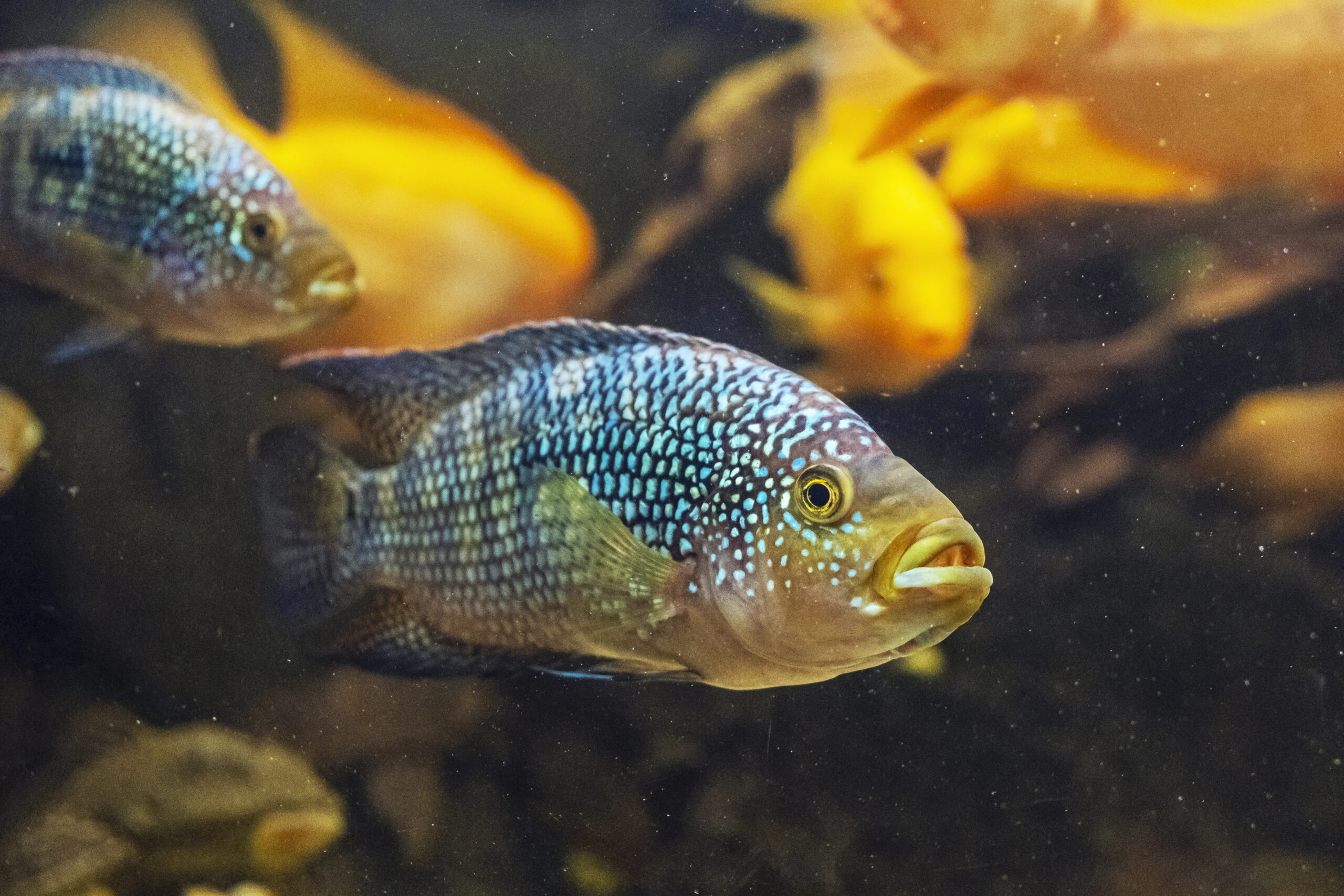
- Scientific Name: Rocio octofasciata
- Adult Size: 8–10 inches
- Care Level: Low
- Origin: Southern Mexico
- Compatible with: Hoplo Catfish, Common Pleco, Firemouth Cichlid, Iridescent Shark, Blue Acara
Pros
- Hardy and adaptable to a variety of tank conditions
- Displays stunning iridescent colors that intensify with age
- Form lifelong breeding pairs and display unique courtship behaviors
Cons
- Become more aggressive as they mature
- Need a spacious setup to avoid constant confrontation
Survivability Score: High if given adequate territory and strong filtration
3. Silver Dollar Fish
Cousins of the piranha, Silver Dollars add shimmer and movement to the tank without adding drama. Their round, metallic bodies and calm temperament provide visual balance in a tank full of predators. A small group of these active swimmers helps reduce their natural skittishness.
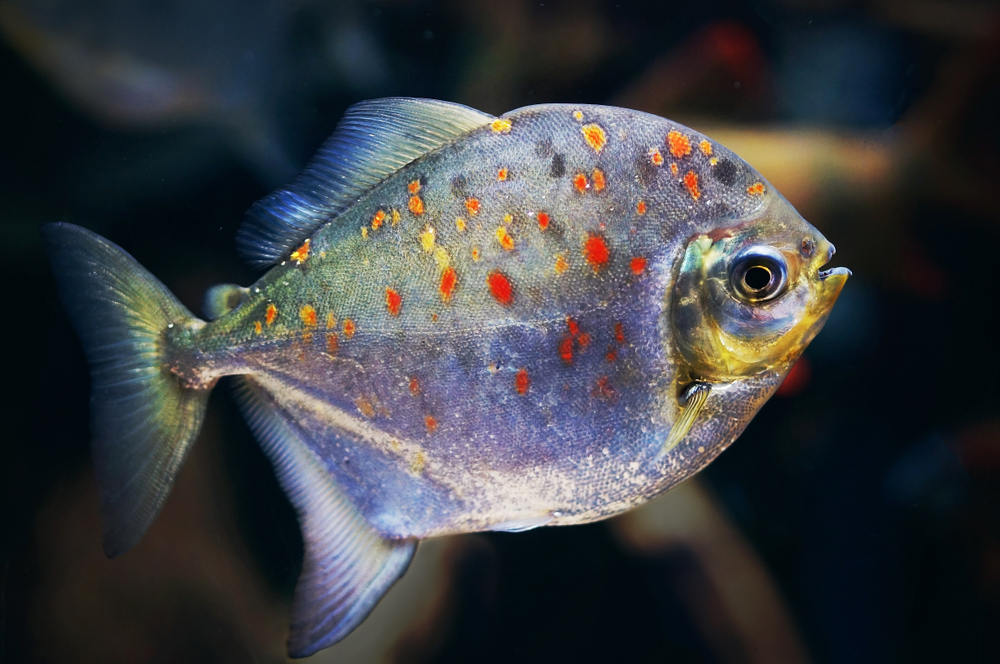
- Scientific Name: Metynnis species
- Adult Size: Up to 6 inches
- Care Level: Easy
- Origin: South America
- Compatible with: Angelfish, Blue Ram Cichlid, Bala Shark
Pros
- Peaceful schooling behavior helps distribute aggression
- Plant-based diet minimizes food competition
- Long lifespan
Cons
- Can be easily startled and prone to jumping
- Require open swimming space and tight lids to prevent escapes
Best For: Aquarists who want a peaceful visual contrast to the piranha’s intensity.
4. Pacu
Calm, powerful, and often mistaken for their infamous cousins, Pacus share the piranha’s general shape but not its temperament. These herbivorous giants are peaceful schooling fish that can coexist with piranhas in large, carefully balanced tanks. Their size and calm nature help maintain stability in mixed communities.
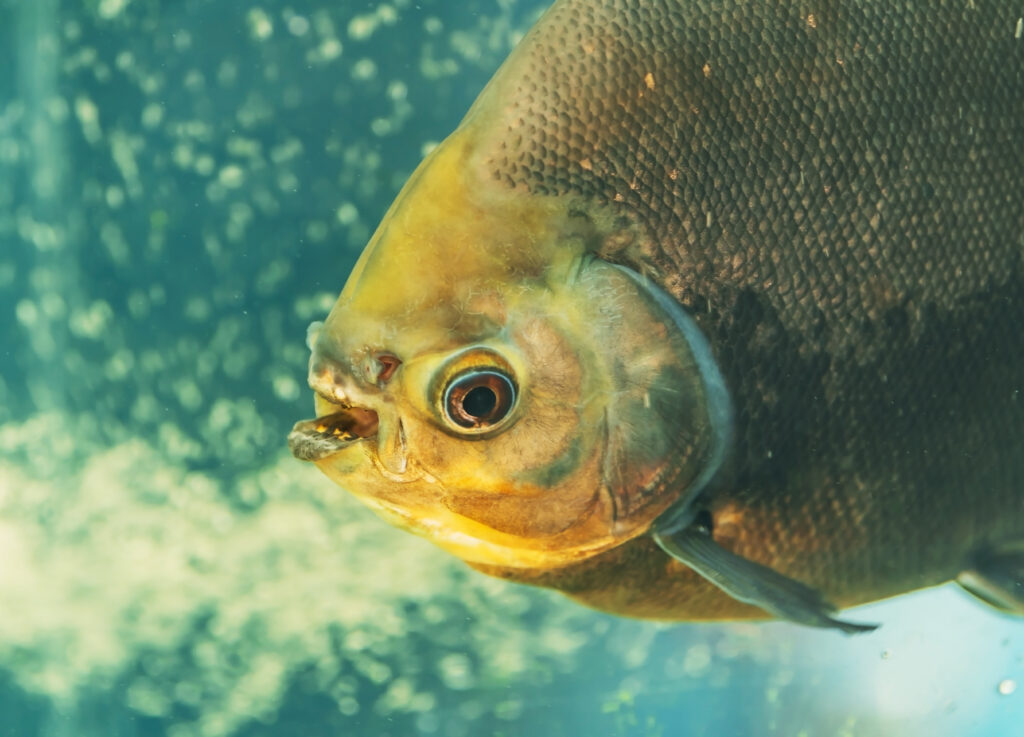
- Scientific Name: Colossoma macropomum
- Adult Size: Up to 35 inches
- Care Level: Moderate
- Origin: South America
- Compatible With: Silver Dollars, Tinfoil Barbs, Plecos, Oscars
Pros
- Peaceful, plant-eating fish that don’t compete for meat-based diets
- Share identical temperature and pH preferences with piranhas
- Visually impressive centerpiece fish
Cons
- Outgrow most home aquariums quickly (often over 3 feet)
- Heavy bioload demands strong filtration
Tank Fit: Suitable for very large aquariums (250+ gallons) where space and water flow allow calm coexistence.
5. Delhezi Bichir
This ancient, armor-plated predator looks like a living fossil. The Delhezi Bichir is calm yet confident, spending much of its time gliding near the bottom of the tank. Its prehistoric appearance adds visual intrigue while its thick scales offer protection against aggression.
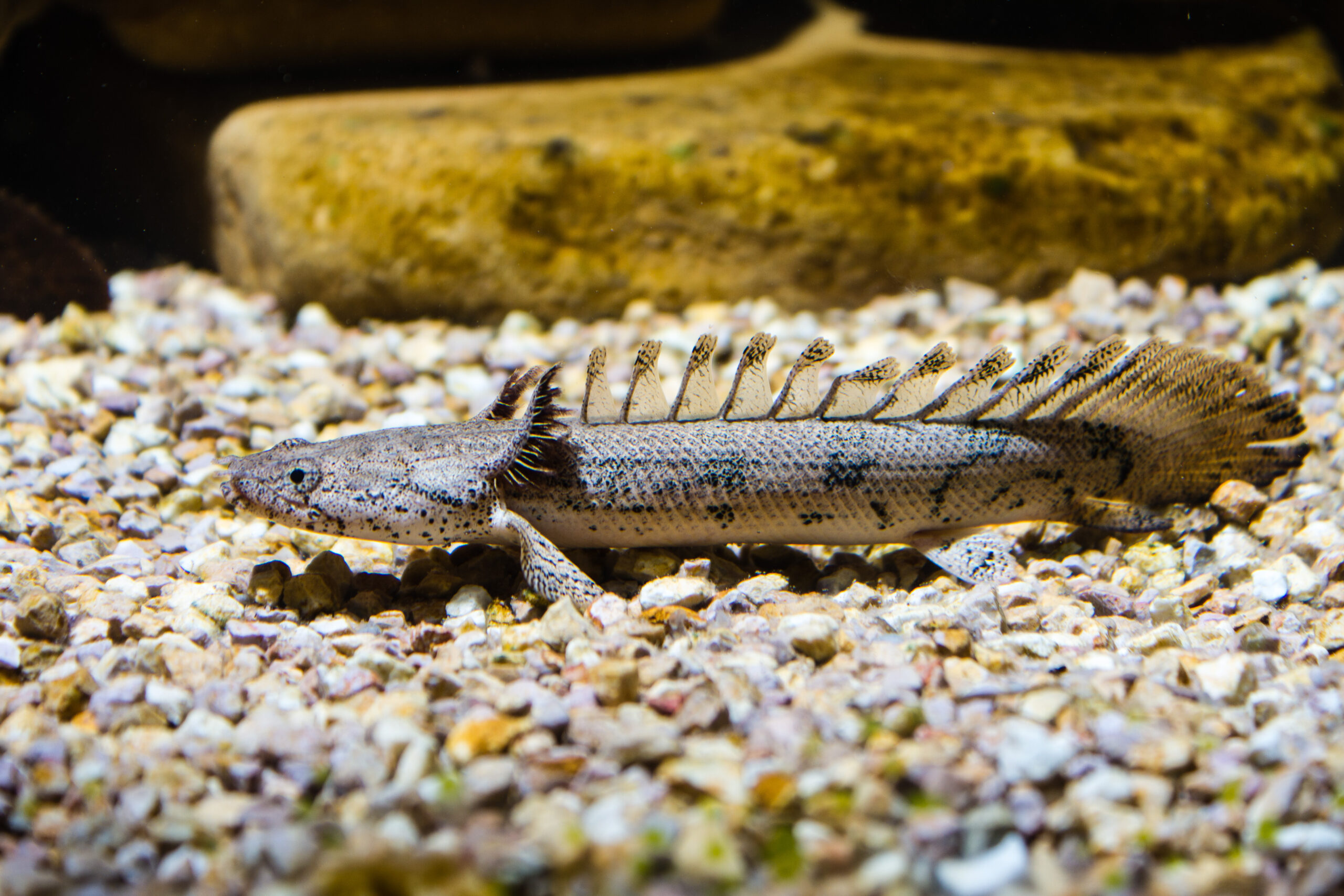
- Scientific Name: Polypterus delhezi
- Adult Size: Up to 17 inches
- Care Level: Easy
- Origin: Central Africa
- Compatible with: Polypterus, Datnoides, Synodontis, African Butterfly Fish, Knife Fish
Pros
- Durable and easy to maintain
- Visually striking and unique in movement and appearance
- Can breathe atmospheric oxygen, allowing survival in lower-oxygen waters
Cons
- Can grow quite large, requiring significant tank space
- Known escape artist that needs a secure lid
Caution Note: Keep the tank tightly covered — Delhezi Bichirs can breathe air and may jump out if given the chance.
6. Common Pleco
Armored, calm, and hardworking, the Common Pleco is a tank janitor that doubles as a survivor. Its algae-eating habits make it an invaluable cleaning crew for larger aquariums, and its tough exterior keeps it safe from most attacks.
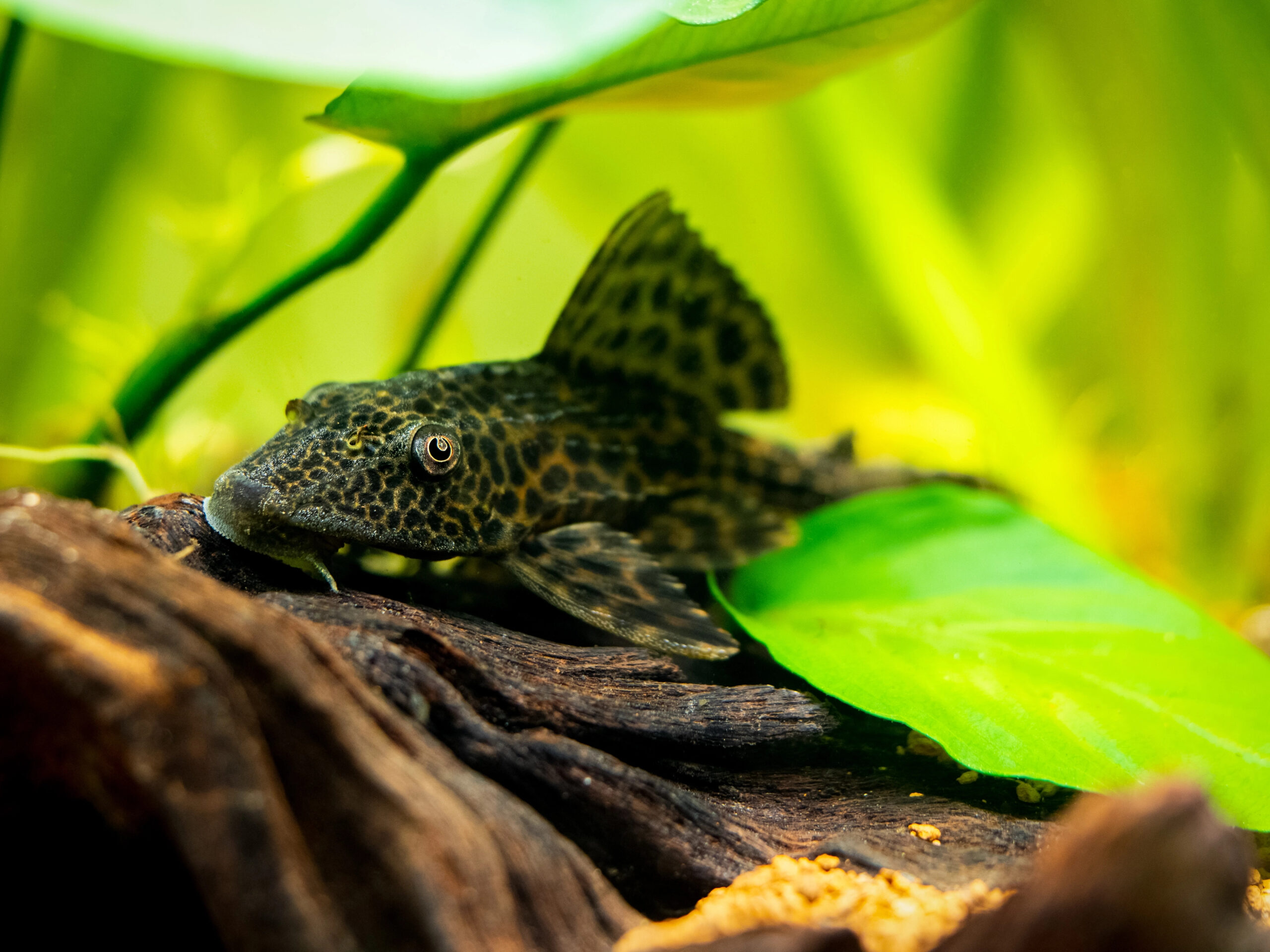
- Scientific Name: Hypostomus plecostomus
- Adult Size: 2–24 inches
- Care Level: Moderate to difficult
- Origin: South America
- Compatible with: Swordtails, Mollies, Tiger Barbs, Neon Tetras, Zebra Danios
Pros
- Excellent algae control that keeps tank maintenance low
- Hard, armored plates provide natural defense against aggression
Cons
- Produces heavy waste, requiring strong filtration
- Needs large tanks with plenty of hiding spots
Tank Match Verdict: Best suited for large aquariums where its cleaning ability can shine without overcrowding.
7. Tinfoil Barb
Energetic and eye-catching, Tinfoil Barbs bring movement and shine to large aquariums. Their silvery bodies and red-tinted fins stand out beautifully against darker species like piranhas. They are fast swimmers that do best in groups, which helps prevent them from becoming targets.
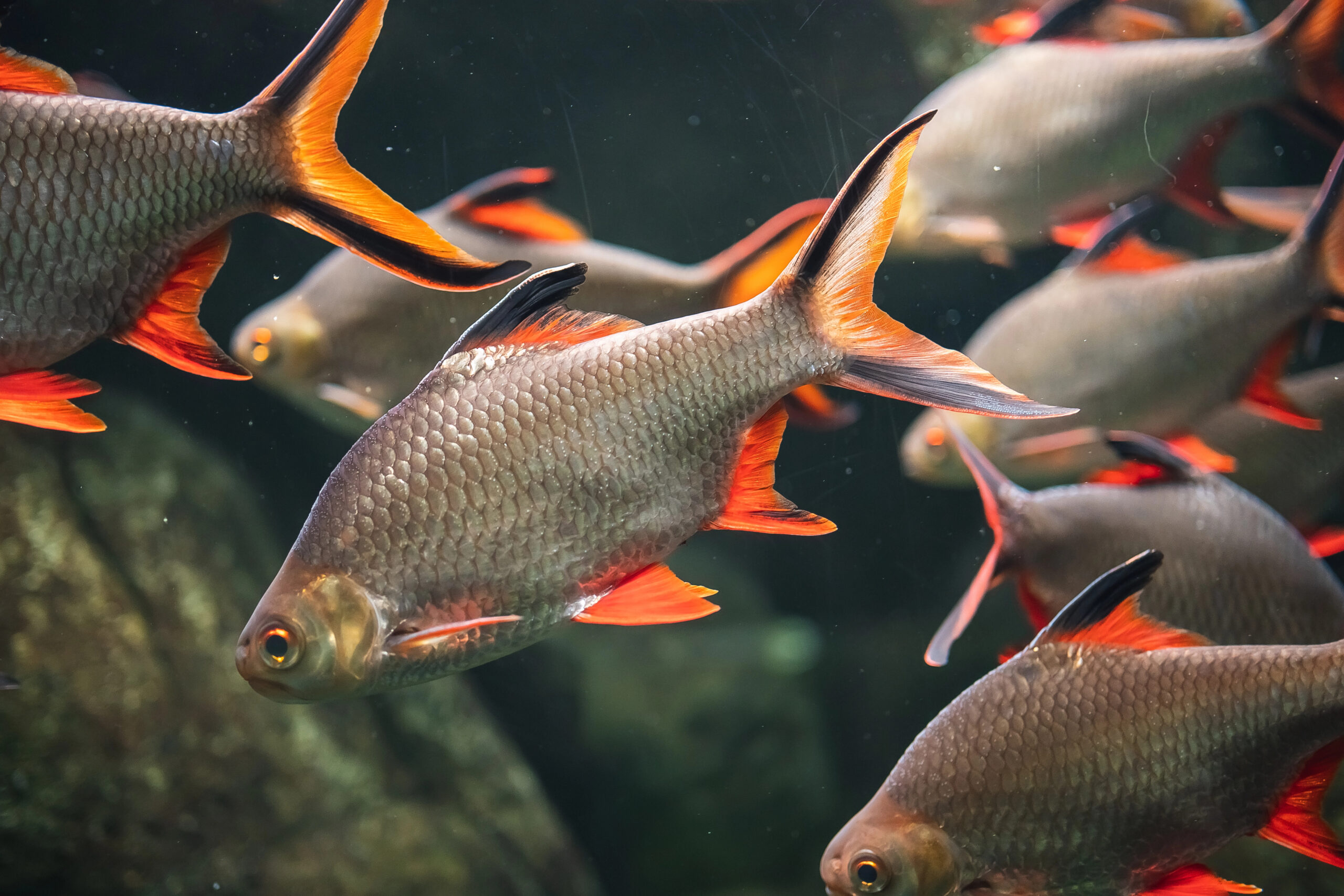
- Scientific Name: Barbonymus schwanenfeldii
- Adult Size: 14–16 inches
- Care Level: Easy
- Origin: Southeast Asia
- Compatible with: Silver Dollar, Plecos, Oscar Cichlid, Angelfish, Bala Sharks
Pros
- Active schooling behavior adds energy to the tank
- Tolerant of a range of water conditions
- Visually striking with metallic scales
Cons
- May nibble on plants and uproot decorations
- Needs strong filtration
- Requires frequent water changes of 20–25 percent every 1–2 weeks to maintain water quality
- Sensitive to low oxygen levels, so proper aeration is critical.
Tank Fit: Best in groups of six or more to spread out aggression and prevent stress.
8. Severum Cichlid
Also known as the Banded Cichlid or Poor Man’s Discus, the Severum combines vivid coloration with a calm temperament. These fish add a pop of color and personality without overwhelming more aggressive species like piranhas.
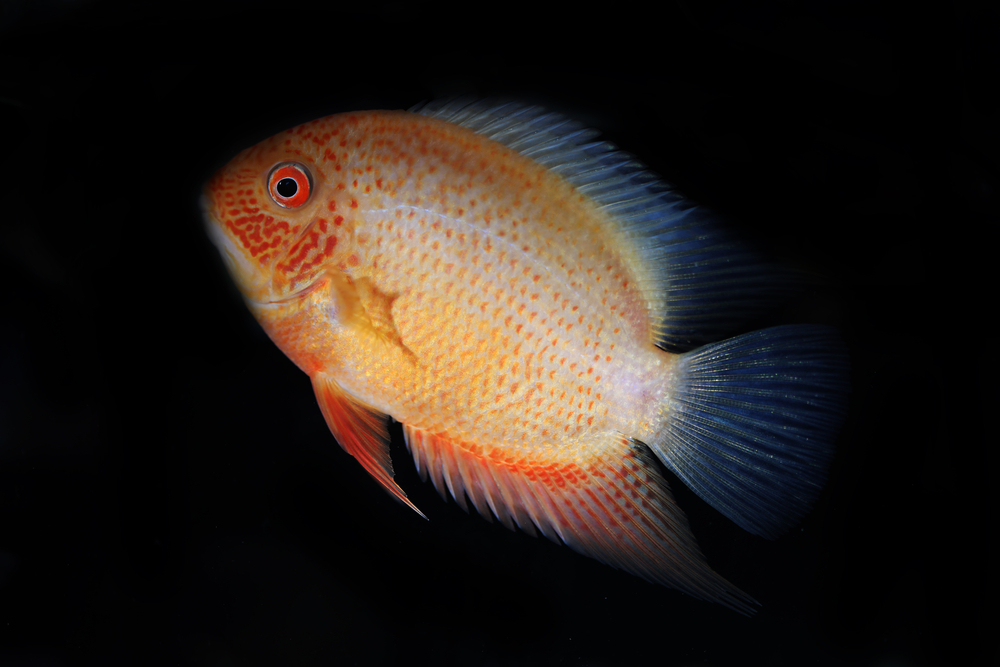
- Scientific Name: Heros severus
- Adult Size: 8–10 inches
- Care Level: Moderate
- Origin: South America
- Compatible with: Angelfish, Oscar, Blood Parrot Cichlid, Hoplo Catfish Black Skirt Tetra
Pros
- Hardy and adaptable to different environments
- Peaceful yet assertive when necessary
- Beautiful colors that deepen as they mature
Cons
- Can be shy in highly aggressive setups
- Susceptible to diseases such as Ich if water quality drops
Best For: Aquarists seeking a colorful, hardy addition that balances personality and peace.
9. Green Terror
Despite its name, the Green Terror can coexist peacefully in a balanced, well-sized tank. Its brilliant metallic blue-green body and orange fin edges make it a standout species that commands attention without constant aggression.
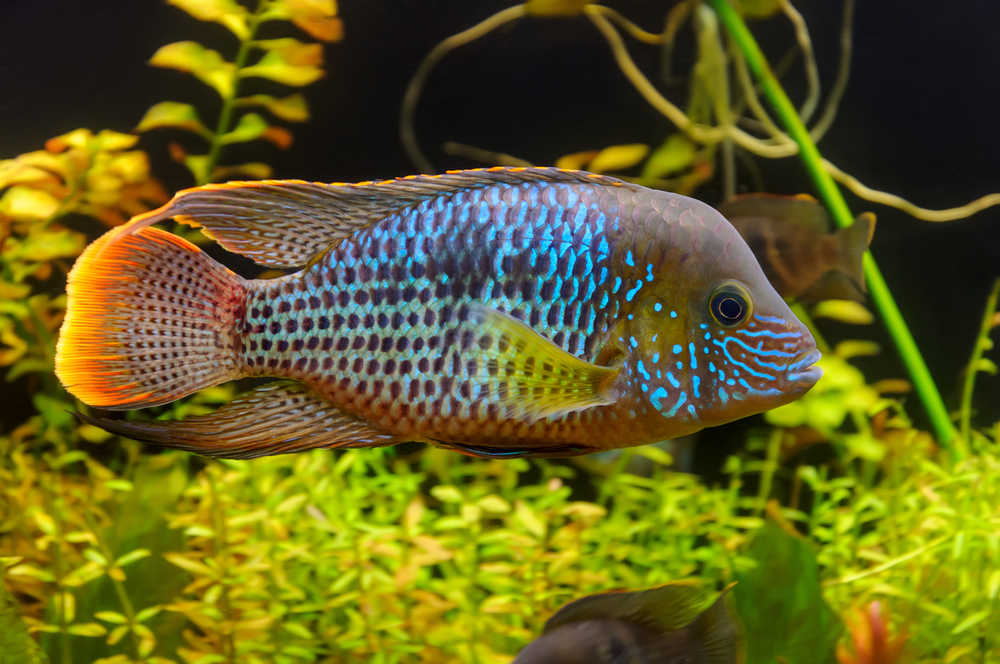
- Scientific Name: Andinoacara rivulatus
- Adult Size: Up to 12 inches
- Care Level: Easy to moderate
- Origin: South America
- Compatible with: Jack Dempsey, Firemouths, Managuense Cichlids, Flowerhorns, Silver Dollars
Pros
- Vibrant colors that intensify with maturity
- Active explorer that uses all levels of the tank
- Adaptable to a variety of water conditions
Cons
- Males can become territorial during spawning
- Requires ample space to prevent aggression
- May harass smaller or slower fish
Tank Fit: Works best with other large, semi-aggressive fish. Males develop bright orange trim on their fins, making them easy to distinguish from females.
10. Red Devil Cichlid
Fiery in both color and temperament, the Red Devil Cichlid lives up to its name. These fish are fiercely territorial and known to rearrange tanks — or destroy heaters — in a show of dominance. They can coexist with piranhas only in exceptionally large setups where each has space to claim.
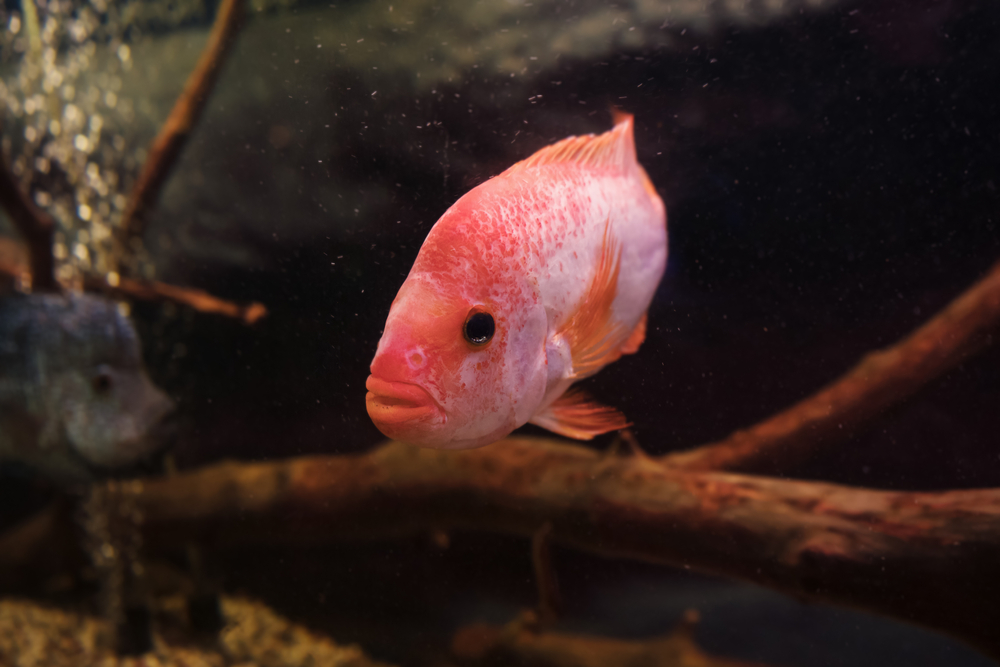
- Scientific Name: Amphilophus labiatus
- Adult Size: Up to 16 inches
- Care Level: Easy
- Origin: Central America
- Compatible with: Red Devil Females and Firemouth Cichlid
Pros
- Extremely interactive and recognizes its owner
- Fascinating breeding and nesting behavior
- Bold coloration and expressive personality
Cons
- Can damage equipment or decor during aggression
- Highly territorial and may attack tank mates
- Requires a very large, reinforced tank
Best For: Expert aquarists managing large, heavily structured aquariums with multiple aggressive species.
11. Iridescent Shark
Graceful and fast-moving, the Iridescent Shark is not a true shark but a catfish species known for its shimmering color and schooling behavior. Its constant motion helps it avoid aggression, but its nervous nature requires an enormous, open tank to minimize stress. These fish can coexist with piranhas if given plenty of room to maneuver.
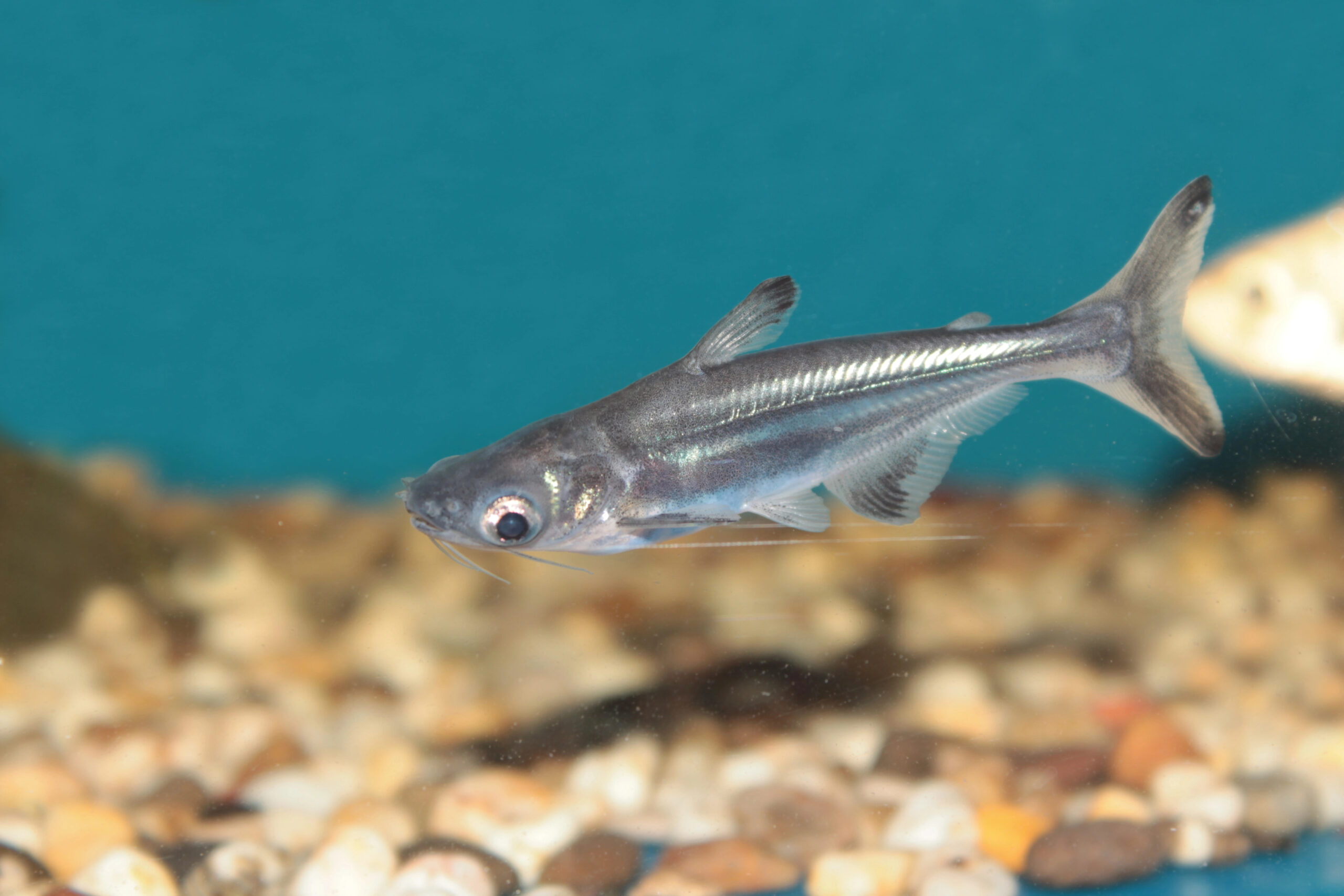
- Scientific Name: Pangasianodon hypophthalmus
- Adult Size: Up to 3.5 feet
- Care Level: Hard
- Origin: Southeast Asia
- Compatible With: Tinfoil Barbs, Giant Gourami, Silver Dollars, Plecos
Pros
- Strong swimmer that naturally avoids confrontation
- Visually striking in large aquariums
- Tolerates similar temperature and pH as piranhas
Cons
- Extremely skittish and prone to injury when startled
- Require 300+ gallons and a long tank footprint
Tank Fit: Best for public or dedicated predator tanks with unobstructed swimming space and subdued lighting.
12. Hoplo Catfish
Peaceful, hardy, and well-armored, the Hoplo Catfish is a resilient bottom-dweller capable of surviving in moderate predator tanks. Its natural armor, calm demeanor, and nocturnal habits help it stay out of the piranha’s way. Hoplos are social and do best in small groups, provided the tank is large enough.
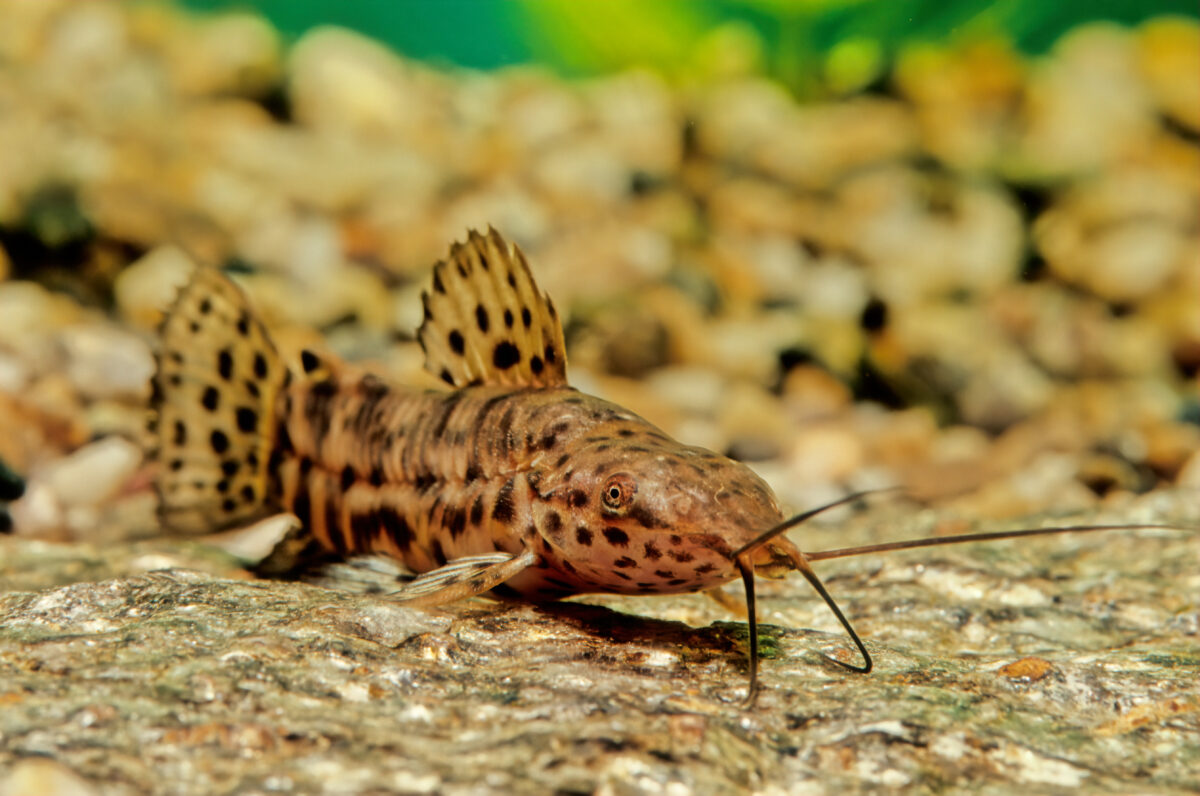
- Scientific Name: Megalechis thoracata
- Adult Size: Up to 6 inches
- Care Level: Easy
- Origin: South America
- Compatible With: Plecos, Bichirs, Corydoras, peaceful cichlids
Pros
- Armored plating provides excellent protection from minor aggression
- Peaceful and easygoing, won’t provoke piranhas
- Adaptable to a range of water conditions
Cons
- Smaller size makes them vulnerable to large or highly aggressive piranhas
- Can be shy if tank lacks hiding spots
Tank Fit: Ideal for planted, sandy-bottom aquariums with multiple caves and visual barriers. Best for juvenile or calm piranha group
13. Convict Cichlid
Small but bold, the Convict Cichlid can sometimes coexist with young or mid-sized piranhas. Their territorial instincts and quick breeding make them resilient, but their smaller size limits long-term success in adult piranha tanks.
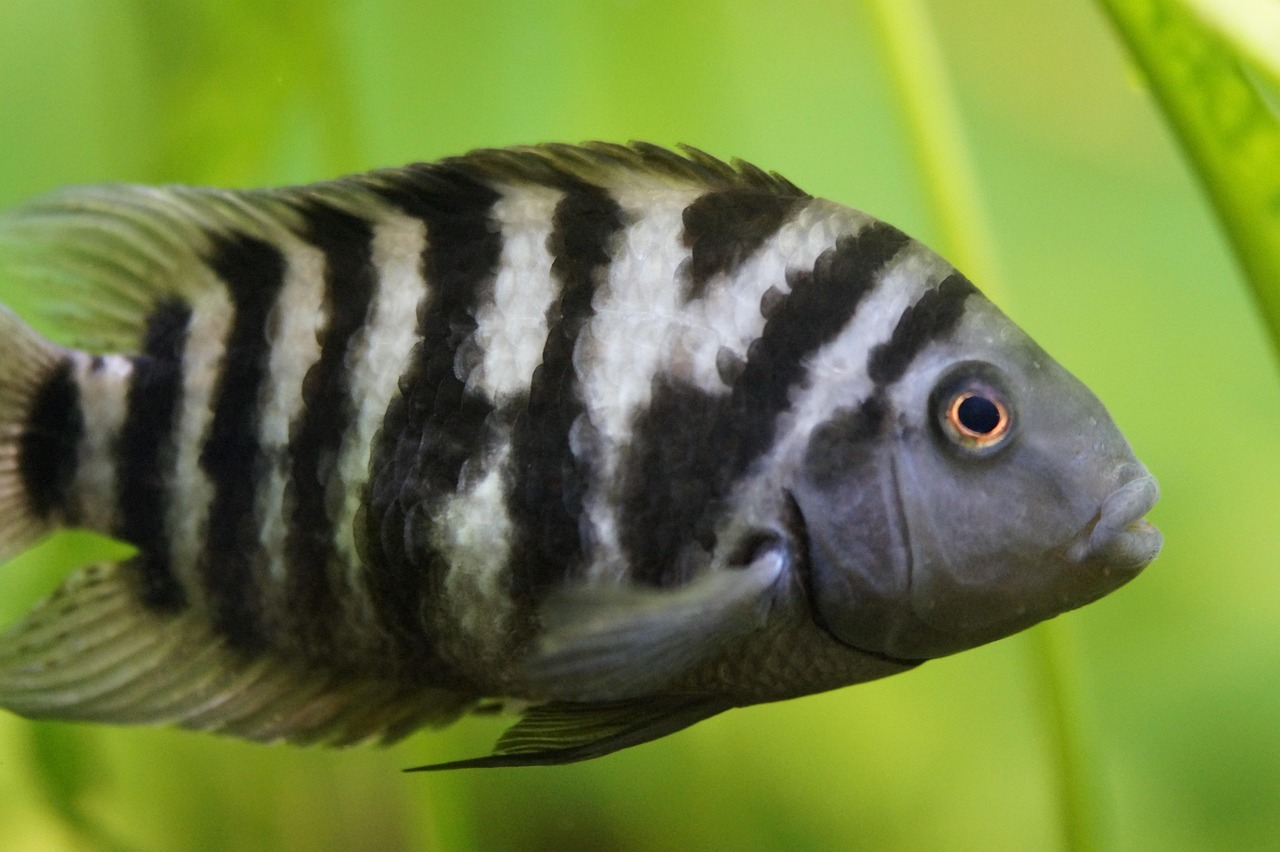
- Scientific Name: Amatitlania nigrofasciata
- Adult Size: 4–6 inches
- Care Level: Easy
- Origin: Central America
- Compatible with: Blood Parrot, Oscars, Angelfish, Pleco
Pros
- Hardy and simple to care for
- Prolific breeders that display interesting parental care
- Easily adapts to various water parameters
Cons
- Extremely territorial during spawning
- Convict Cichlids are prone to several diseases, including Hole in the Head, Tuberculosis, Gill Flukes, Ich Disease, and Cotton Wool Disease
Survivability: Moderate, only in well-structured setups or with juvenile piranhas.
14. Firemouth Cichlid
Brilliantly colored and bold without being reckless, the Firemouth Cichlid adds a flash of red to any tank. Males are known for their signature throat-flaring displays, a behavior used to assert dominance and ward off rivals. Despite their name, they are among the more peaceful Central American cichlids when given enough room.
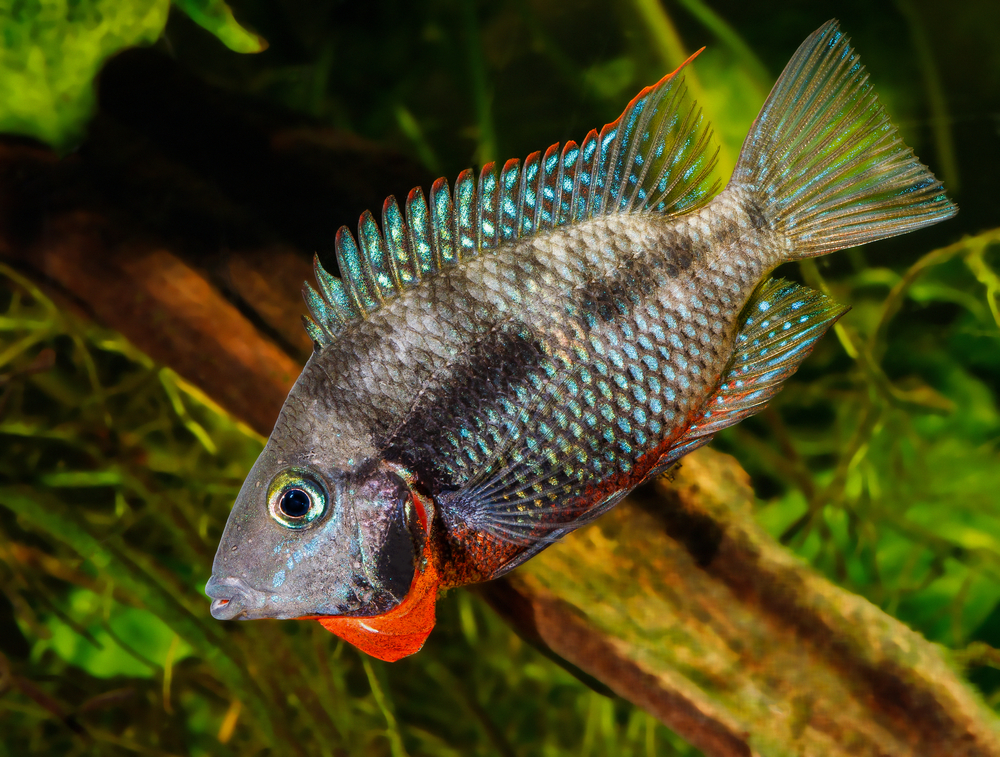
- Scientific Name: Thorichthys Meeki
- Adult Size: Up to 6 inches
- Care Level: Easy
- Origin: Central America
- Compatible with: Rummy Nose Tetra, Clown Pleco, Bristlenose, Rainbowfish, Swordtails
Pros
- Striking coloration and engaging behavior
- Peaceful temperament when kept in a well-spaced tank
- Low-maintenance care requirements
Cons
- May nip fins of long-finned fish such as angelfish
- Needs stable water quality to maintain vibrant color
Best For: Aquarists seeking a colorful, semi-peaceful species that thrives in warm, still water environments.
15. Giant Gourami
The Giant Gourami’s calm personality and impressive size can make it a surprising candidate for piranha tanks — provided the aquarium is enormous. These fish produce heavy waste and are slow-moving, so they only succeed when their size alone deters aggression.
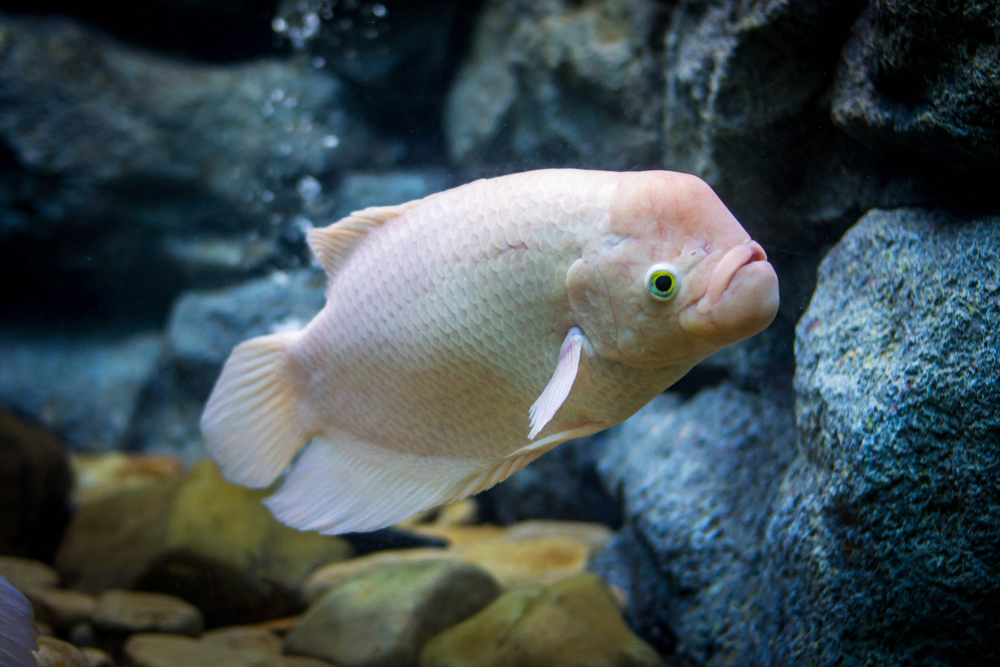
- Scientific Name: Osphronemus goramy
- Adult Size: 16–18 inches
- Care Level: Easy
- Origin: SouthAsia
- Compatible with: Oscar, Blood Parrot, Pleco, Redtail Catfish
Pros
- Peaceful with similarly sized tank mates
- Long-lived and hardy in stable conditions
- Capable of forming unique bonds with keepers
Cons
- Extremely messy eaters that produce heavy waste
- Require a minimum 200-gallon tank with strong filtration
Tank Fit: Suitable for massive, well-filtered aquariums (200+ gallons). Not recommended for community setups.
16. Red-Tailed Catfish
The Red-Tailed Catfish is one of the most visually striking and fast-growing freshwater predators. Recognizable by its bright red tail and elongated body, this species is both impressive and demanding. However, this species regularly exceeds four feet in length and outgrows almost every home aquarium within a year.

- Scientific Name: Phractocephalus hemioliopterus
- Adult Size: 4–5 feet
- Care Level: Hard
- Origin: South America
- Compatible with: Other Red Tail Catfish, Gars, Freshwater Stingrays
Pros
- Incredible growth rate and unique appearance
- Long lifespan when properly housed
Cons
- Outgrows home aquariums within the first year
- Requires an exceptionally large tank or public aquarium
- Can consume smaller tank mates whole
Tank Fit: Impressive but impractical. Best suited for public aquariums or collectors with ponds designed for mega fish.
17. Striped Raphael Catfish
The Striped Raphael Catfish, also known as the “Talking Catfish,” is a hardy nocturnal bottom-dweller famous for the squeaking sound it makes when handled. Its black body and cream-colored stripes make it both beautiful and functional, as it helps keep tanks clean by scavenging leftovers.
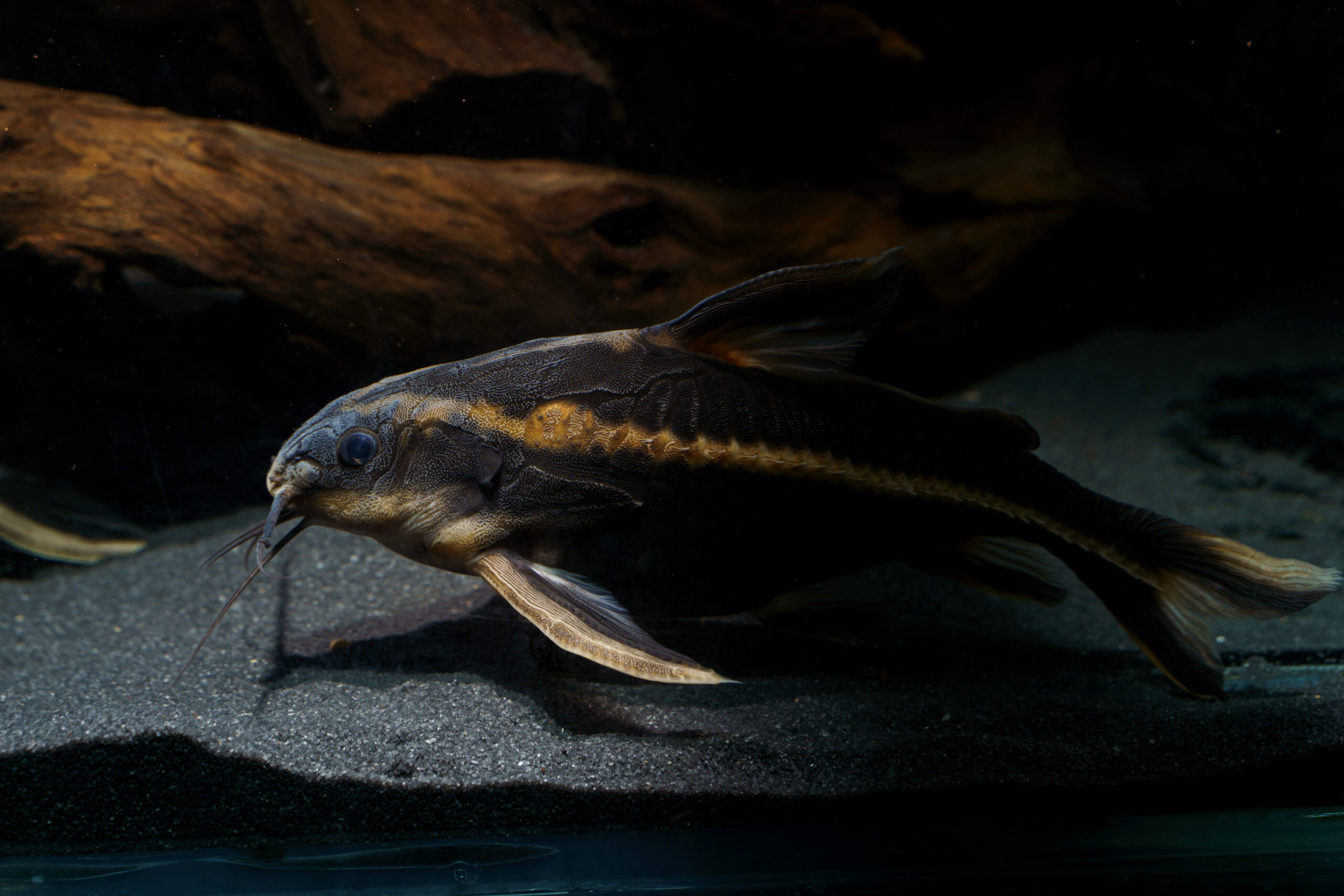
- Scientific Name: Platydoras Armatulus
- Adult Size: 8–9.5 inches
- Care Level: High
- Origin: South America
- Compatible with: Other fish of the same specie
Pros
- Armed with sharp spines for self-defense
- Peaceful, social, and low-maintenance when housed properly
- Helps clean up uneaten food
Cons
- Needs warm, stable temperatures with supplemental heating
- Requires large tanks with plenty of hiding areas
- Can be reclusive during daylight hours
Caution Note: These catfish are vocal when out of water and may “talk” by producing squeaking sounds. Handle carefully, as their sharp spines can catch on nets.
18. African Arowana
Sleek, ancient, and graceful, the African Arowana is a powerful surface-dweller that adds elegance to large aquariums. It can breathe air, leap out of the water, and grow to over three feet in length, making it best suited for advanced aquarists.
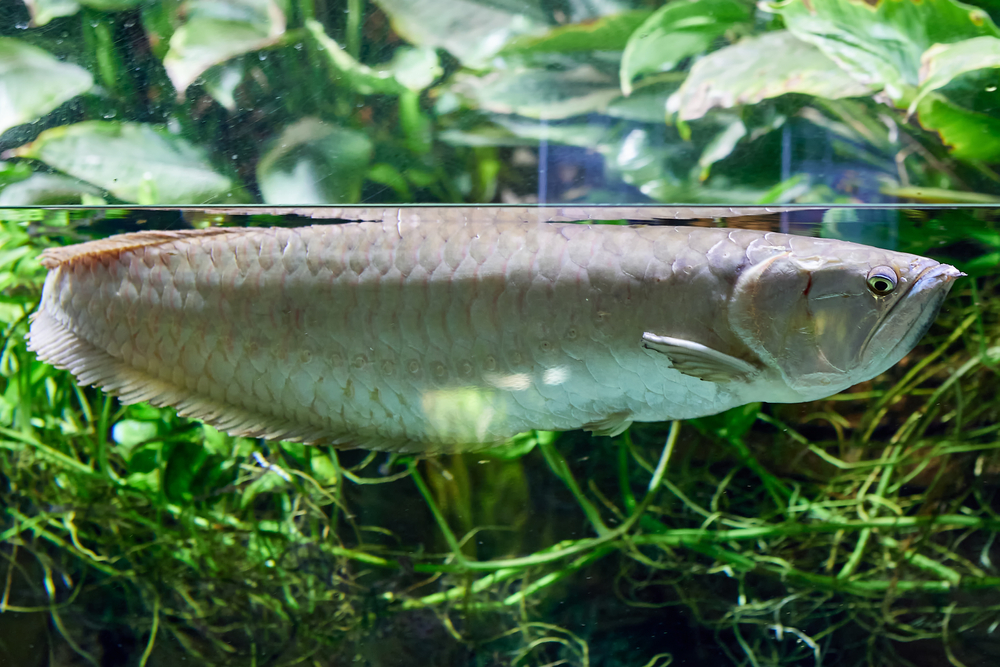
- Scientific Name: Heterotis niloticus
- Adult Size: 3.3 feet
- Care Level: Hard
- Origin: Watersheds throughout Africa
- Compatible with: Cichlids, Xenomystus, Synodontis, Astronotus, Oscars, and Channel Catfish
Pros
- Peaceful with similarly sized, non-aggressive fish
- Fascinating surface-feeding behavior and unique look
- Adapted to survive in low-oxygen environments
Cons
- Requires a tightly covered tank to prevent jumping
- Large appetite and heavy waste production
- Difficult to source and maintain for beginners
Survivability Score: Moderate. Highly capable in experienced hands but risky for smaller or uncovered setups.
Piranha Tank Mate Comparison Chart
Not every fish has what it takes to share space with a piranha. The Survivability Score below reflects how well each species can coexist based on three factors:
- Temperament Match (40%) – How well the fish’s personality balances with a piranha’s aggression
- Environmental Compatibility (35%) – Similarity in temperature, pH, and habitat needs
- Practicality (25%) – How realistic the pairing is in a home aquarium, considering tank size, diet, and care demands
A higher score means a better long-term match for most aquarists, while lower scores suggest the pairing is more difficult to maintain.
| Fish | Temperament | Care Level | Ideal Setup | Survivability Score |
|---|---|---|---|---|
| Oscar Fish | Semi-aggressive | Moderate | 100+ gal, hardy cichlid setup | 8/10 |
| Jack Dempsey | Aggressive | Low | 100+ gal, strong filtration | 8/10 |
| Silver Dollar Fish | Peaceful | Easy | 75+ gal, group of 5+ | 7/10 |
| Pacu | Peaceful | Moderate | 250+ gal, herbivorous community | 8/10 |
| Delhezi Bichir | Semi-aggressive | Easy | 100+ gal, secure lid | 9/10 |
| Common Pleco | Peaceful | Moderate | 125+ gal | 9/10 |
| Tinfoil Barb | Active, social | Easy | 150+ gal, group of 6+ | 7/10 |
| Severum Cichlid | Semi-aggressive | Moderate | 75+ gal, calm companions | 8/10 |
| Green Terror | Aggressive | Easy–Moderate | 100+ gal, large tankmates | 7/10 |
| Red Devil Cichlid | Highly aggressive | Easy | 125+ gal, solo or species tank | 5/10 |
| Iridescent Shark | Skittish | Hard | 300+ gal, open swimming space | 6/10 |
| Hoplo Catfish | Peaceful | Easy | 75+ gal, sandy bottom, planted tank | 7/10 |
| Convict Cichlid | Aggressive | Easy | 55+ gal, structured territory | 6/10 |
| Firemouth Cichlid | Semi-aggressive | Easy | 55+ gal, planted zones | 8/10 |
| Giant Gourami | Peaceful | Easy | 200+ gal, clean water flow | 6/10 |
| Red-Tailed Catfish | Predatory | Hard | 500+ gal+, public aquarium | 3/10 |
| Striped Raphael Catfish | Peaceful | High | 75+ gal, hiding caves | 8/10 |
| African Arowana | Peaceful | Hard | 300+ gal, tight lid | 6/10 |
Frequently Asked Questions
Piranhas can coexist with a few select species, but it takes planning and patience. Below are some of the most common questions aquarists ask before attempting a mixed setup.
Don’t see your question? Ask us in the comments!
Are there any non-fish tank mates that can be kept with piranhas?
It is generally not recommended to keep non-fish species with piranhas. Their carnivorous diet and territorial nature make them likely to attack smaller creatures such as snails, shrimp, or frogs.
Even hardy invertebrates are at risk once the piranhas mature. For best results, stick with similarly sized, confident fish species instead.
How should I introduce new tank mates to a piranha tank?
Introduce all fish at the same time if possible to reduce territorial behavior. Rearrange decor and add new hiding spots before adding tank mates to disrupt existing territories.
Closely monitor interactions for the first 48 hours. If a fish is repeatedly chased, injured, or shows signs of stress, it should be relocated immediately.
Do piranhas eat other piranhas?
Yes, they can. Cannibalism is most common among juvenile piranhas kept in tight quarters or when food is scarce.
In adult groups, aggression usually occurs over territory or dominance, not hunger. A spacious tank, a steady feeding routine, and dense vegetation can minimize fighting.
What is the ideal tank size for keeping piranhas with other fish?
A minimum of 100 gallons is required for a small group of red-bellied piranhas with a few large, compatible tank mates. Each additional large fish typically adds 30–50 gallons to the total requirement.
Bigger is always better when it comes to piranhas — cramped conditions almost always lead to aggression.
Can piranhas be kept with smaller fish if they are well-fed?
Regular feeding does not eliminate the piranha’s predatory instincts. Even well-fed individuals may attack smaller or slower fish that enter their territory.
If you want to experiment with mixed species, all fish should be of similar size and temperament to avoid easy targets.
What do I do if a piranha injures or kills a tank mate?
Remove the injured fish immediately to prevent further stress and bacterial spread. Evaluate the tank for crowding, poor water quality, or competition during feeding.
In many cases, separating the aggressive piranha or increasing space resolves the problem.
More Tricky Pairings
If you think piranhas are tough tank mates, meet the other species that challenge even experienced aquarists.
